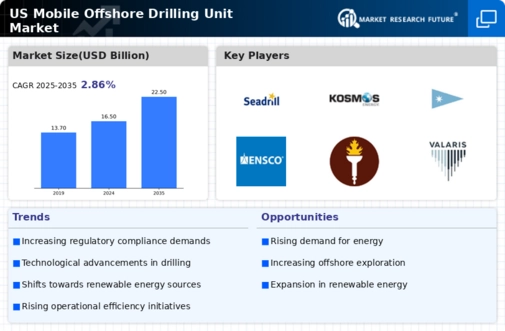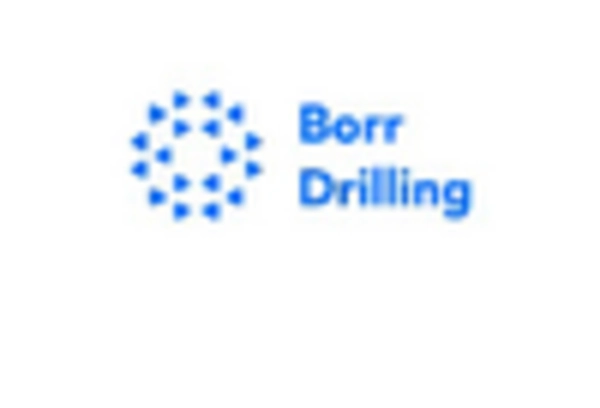Geopolitical Factors
Geopolitical factors significantly impact the mobile offshore-drilling-unit market. The US's position in the global energy landscape is influenced by international relations, trade policies, and geopolitical tensions. Fluctuations in oil prices, often driven by geopolitical events, can affect investment decisions in offshore drilling. For instance, when tensions arise in oil-producing regions, the price of crude oil may spike, prompting US companies to increase their offshore drilling activities to capitalize on higher prices. Additionally, the US government's policies regarding energy independence and foreign relations can shape the mobile offshore-drilling-unit market. As the US seeks to reduce its reliance on foreign oil, there may be a greater emphasis on domestic offshore drilling, potentially leading to increased demand for mobile offshore drilling units. Thus, geopolitical dynamics are likely to remain a key driver in the evolution of the mobile offshore-drilling-unit market.
Rising Energy Demand
The mobile offshore-drilling-unit market is experiencing a surge in demand driven by the increasing need for energy resources. As the US economy continues to grow, the consumption of energy is projected to rise, necessitating the exploration and extraction of oil and gas reserves. According to the US Energy Information Administration, energy consumption is expected to increase by approximately 10% by 2030. This growing demand for energy resources is likely to propel investments in offshore drilling activities, thereby enhancing the mobile offshore-drilling-unit market. Furthermore, the shift towards cleaner energy sources may also lead to a greater emphasis on natural gas extraction, which is often facilitated by mobile offshore drilling units. Consequently, the market is poised for growth as energy companies seek to meet the rising energy needs of the nation.
Environmental Regulations
Environmental regulations are increasingly influencing the mobile offshore-drilling-unit market. The US government has implemented stringent regulations aimed at minimizing the environmental impact of offshore drilling activities. Compliance with these regulations often requires the adoption of advanced technologies and practices, which can lead to increased operational costs. However, these regulations also create opportunities for innovation within the mobile offshore-drilling-unit market. Companies that invest in environmentally friendly technologies may gain a competitive advantage, as they can meet regulatory requirements more effectively. Additionally, the growing public awareness of environmental issues is prompting companies to adopt sustainable practices, further driving the demand for mobile offshore drilling units that comply with these regulations. As the regulatory landscape continues to evolve, the mobile offshore-drilling-unit market is likely to adapt and thrive.
Technological Innovations
Technological innovations play a pivotal role in shaping the mobile offshore-drilling-unit market. The introduction of advanced drilling technologies, such as automated drilling systems and real-time data analytics, has the potential to enhance operational efficiency and reduce costs. These innovations allow for more precise drilling operations, minimizing the risk of accidents and environmental impacts. The US offshore drilling sector has seen a significant increase in the adoption of such technologies, with estimates indicating that companies could save up to 20% in operational costs through improved efficiency. Furthermore, the integration of digital technologies, such as the Internet of Things (IoT), is expected to revolutionize the way mobile offshore drilling units operate. As these technologies continue to evolve, they are likely to drive growth in the mobile offshore-drilling-unit market by attracting new investments and improving overall performance.
Investment in Offshore Infrastructure
Investment in offshore infrastructure is a critical driver for the mobile offshore-drilling-unit market. The US government and private sector are increasingly allocating funds towards the development of offshore facilities, which include drilling rigs and support vessels. In recent years, the US has seen a notable increase in capital expenditure in the oil and gas sector, with estimates suggesting that spending could reach $100 billion annually by 2026. This influx of investment is likely to enhance the capabilities and efficiency of mobile offshore drilling units, making them more attractive to operators. Additionally, the modernization of existing infrastructure is expected to improve safety and environmental compliance, further stimulating the mobile offshore-drilling-unit market. As companies invest in advanced technologies and equipment, the overall productivity and profitability of offshore drilling operations are anticipated to improve.

















Leave a Comment